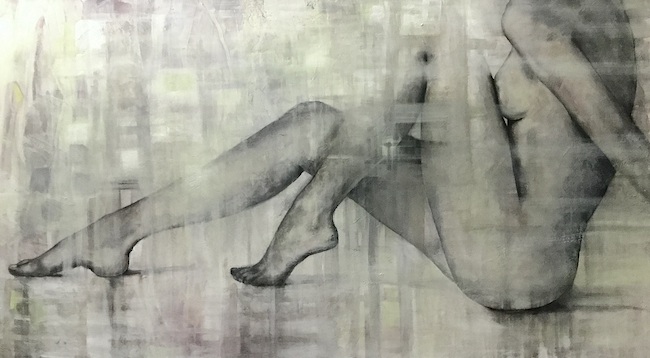L’attenzione alle pulsioni interiori che contraddistingue l’arte contemporanea, quel vortice di emozioni, di insicurezze e di destabilizzazioni che non può prescindere dai frenetici ritmi attuali e dalla solitudine dell’individuo illuso di essere in mezzo a una moltitudine grazie alla tecnologia, tende ad allontanare a volte gli artisti da quell’equilibrio con un approccio più estetico, più figurativo anche se orientato comunque a esplorare, proprio attraverso l’esteriorità, quelle sensazioni intime e interiori che nella quotidianità vengono nascoste. La protagonista di oggi dà vita a opere in cui il corpo femminile si trasforma in mezzo di approfondimento, di conoscenza di sé, di manifestazione di una necessità meditativa volta a svelare tutti quei pensieri, quelle riflessioni attraverso le quali è possibile prendere atto degli eventi, delle circostanze, delle conseguenze.
Il fascino del corpo nella sua nudità ha costituito un importante punto fermo per tutta l’arte classica, sia per quanto concerne la pittura che la scultura, perché la perfezione della forma, l’attenzione all’estetica erano linee guida irrinunciabili per rappresentare atleti, danzatori, guerrieri sottolineando la loro perfezione fisica, la forza e il vigore, ma anche per indurre il pubblico a considerare la nudità un qualcosa di naturale; lentamente nel corso dei secoli anche la pittura storica, allegorica e sacra hanno scelto il nudo per narrare vicende ed eventi. Poi, dopo la lunga pausa degli anni bui del Medioevo, la pittura ha cominciato a scoprire anche il corpo femminile nella sua bellezza pura e al tempo stesso sensuale, innocente ma anche provocante, in cui l’attenzione all’estetica era sempre prevalente sul sentire interiore. Francisco Goya con la sua Maya Desnuda, che scandalizzò il mondo culturale dell’epoca per il fatto che l’artista avesse ritratto una donna comune, dunque non più una figura mitologica, all’interno di un contesto moderno e senza preoccuparsi di nascondere nulla di quella nudità, fu il capostipite di un genere che ha attraversato tutti gli stili pittorici e che ha reso la donna protagonista dello sguardo ammirato e ammaliato dei più grandi maestri di ogni tempo. Gustave Courbet rappresentò il corpo femminile in modo esplicito, quasi pornografico sia nella tela Il sonno sia nella controversa Origine du monde e a sua volta Edouard Manet con la sua Olympia suscitò altrettanto scandalo per l’aspetto profano della donna, accomunabile a una prostituta, con cui l’artista volle forse puntare l’accento sulle abitudini del mondo maschile dell’epoca; e ancora nel Secessionismo Viennese Gustav Klimt ritornò all’essenza provocatoria e al contempo elegante e raffinata della donna nelle tele Nuda Veritas e Danae in cui comincia a subentrare l’imperfezione fisica che però non compromette in alcun modo la sensualità e la bellezza delle figure femminili ritratte. Il percorso di Klimt fu ampliato dall’espressionista Egon Schiele in cui il nudo rappresentava il suo personale modo di esprimere il senso di disorientamento, di disperazione di un’epoca a metà tra la prima e la seconda guerra mondiale, quando tutte le certezze erano crollate e il timore di perdere la vita induceva ad aggrapparsi a essa anche attraverso l’incontro fisico. In lui l’attenzione all’estetica era messa in secondo piano rispetto al sentire, alla rilevanza di tutto quel mondo interiore che doveva necessariamente prevalere tanto quanto, qualche anno dopo, fu sottolineato da Lucian Freud appartenente alla Scuola di Londra, in cui la corpulenza dei personaggi narrati esprimeva un disagio psicologico e interiore riflettendo la loro incapacità di trovare un senso alla vita.
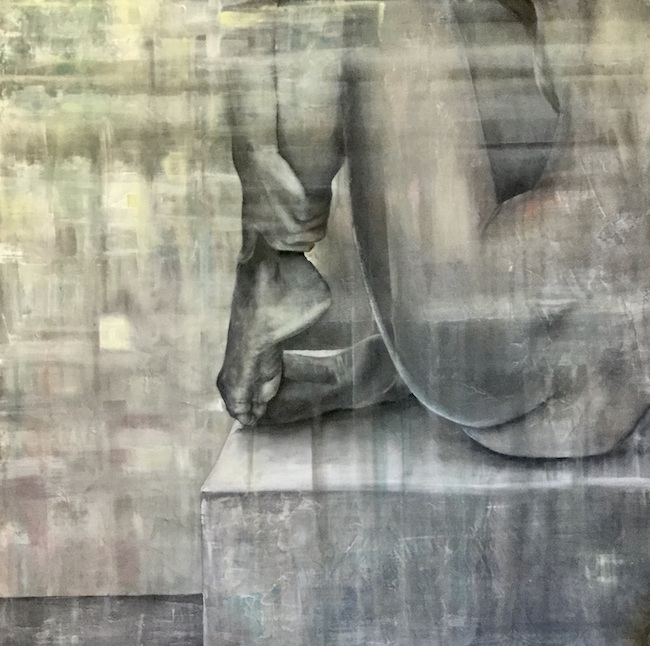
L’artista romana Claudia Nardi torna alla perfezione estetica del corpo femminile, mostrando uno stile quasi Fotorealista nell’attenzione al dettaglio, nella descrizione della forma perfetta, che però vela, quasi nascondendo, e avvolge le sue protagoniste di un silenzio a loro necessario per approfondire il dialogo con se stesse, quello a cui si può dare vita solo nel momento in cui si è disposte a mettersi a nudo e osservare la propria interiorità. Ecco dunque che la nudità esterna diviene metafora che l’artista usa per suggerire un percorso necessario per arrivare alla consapevolezza di sé, quello che normalmente viene nascosto tra contingenza e bisogno di apparire al meglio dimenticando di essere. La tecnica di sfumare e velare l’immagine principale è funzionale proprio a evidenziare la discrezione, la riservatezza che la Nardi ha nei confronti dei suoi personaggi, come se li osservasse ma poi li lasciasse alla loro introspezione, allo stesso modo di una guida che però sa farsi da parte per lasciare che la consapevolezza cresca e maturi all’interno di ciascuno.
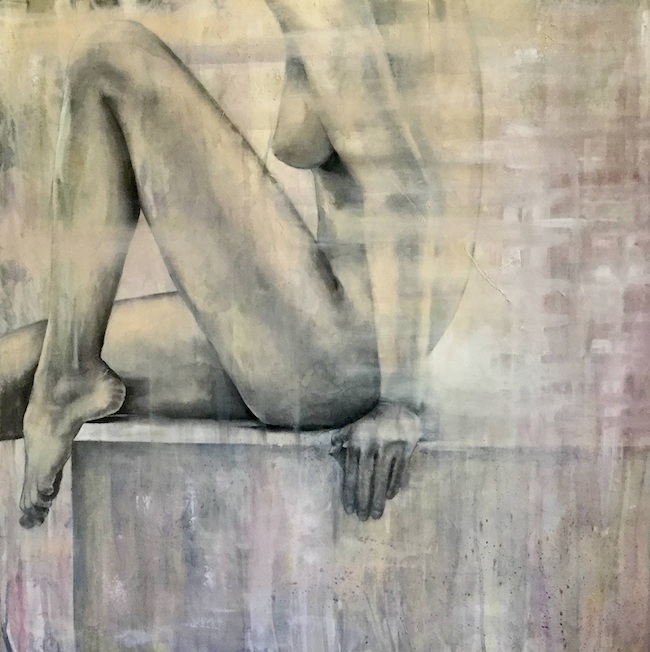
Il non dare un’identità specifica tralasciando i volti diviene essenziale per infondere nell’osservatore maggiore partecipazione, identificandosi nel sentire, avvicinandosi attraverso l’impulso emozionale, ritrovandosi in un percorso di consapevolezza che egli stesso ha compiuto o sa di dover compiere; la scelta del corpo femminile è probabilmente dovuta alla consapevolezza che molto spesso il percorso di liberazione emozionale, di affrancarsi da un’interiorità ingabbiata dalle convenzioni e dalle proprie insicurezze, è più incisivo, parte quasi dalla donna per poi propagarsi agli individui che la circondano, al resto della società. Le pose dei corpi sono classiche eppure contemporanee perché è attraverso un singolo gesto, un particolare fermo immagine che Claudia Nardi riesce a esprimere la sensazione che le sue protagoniste affrontano, di volta in volta, in quel momento di introspezione a cui seguirà una intensa presa di coscienza, da cui potrà partire un’evoluzione, una modificazione proprio perché il capire, l’interrogarsi e l’accettare il corso degli eventi è necessario per trattenere ciò che è insegnamento necessario e lasciar andare ciò che invece non può essere modificato e dunque preso come la causa che ha originato effetti determinanti.
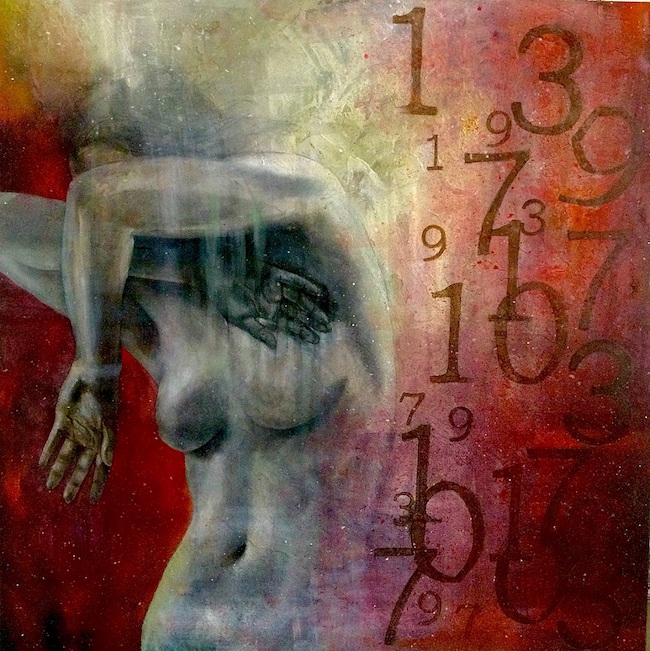
È incisiva l’artista nel raccontare le emozioni solo attraverso uno scorcio, un frammento di esistenza di quelle donne che rappresentano la delicatezza, la fragilità ma anche la forza interiore che permette loro di effettuare un cammino di conoscenza, di approfondimento degli accadimenti ma anche di superarne gli esiti.
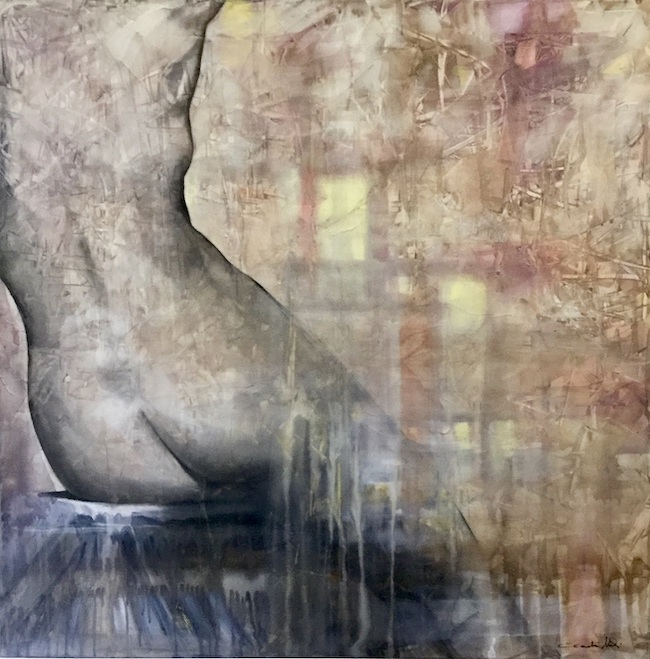
Eppure per compiere quel cammino è anche fondamentale avvolgersi in un suggestivo quanto essenziale silenzio, che la Nardi esprime attraverso le velature che sembrano quasi voler nascondere ciò che in realtà non può fare a meno di emergere, appaiono come atmosfere soffuse indispensabili per incentivare l’ascolto interiore, come se solo dopo essere stati nella nebbia sia possibile trovare la luce.
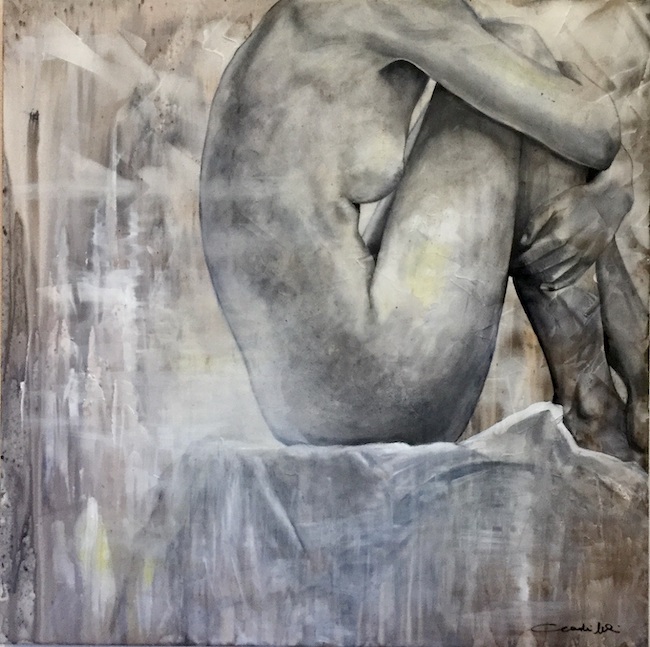
In alcuni casi le donne sono ritratte di spalle rispetto all’osservatore, quasi a voler mantenere un distacco necessario con il mondo esterno, quasi a decidere di rifiutare di esporsi perché il farlo le indurrebbe a sentirsi più fragili, in pericolo e senza protezione; in altre tele invece sembrano raccogliersi in se stesse, abbracciando le gambe per raggomitolarsi e trovare quel contatto tra interno ed esterno in virtù del quale meditare, riflettere su tutto ciò che è stato fino a quel momento e intravedendo ciò che potrà essere da lì in avanti, malgrado le incertezze, a dispetto delle cadute che se è vero che hanno compromesso la stabilità e la sicurezza dall’altro hanno indotto a scoprire la propria forza, la determinazione nel rialzarsi. Altre tele mostrano invece una spiccata consapevolezza di sé, la certezza di sapere cosa volere e quale direzione prendere per ottenerlo e allora il frangente immortalato dalla Nardi diviene semplicemente un momento di pausa, di raccolta delle idee e di pianificazione del successivo obiettivo, una quiete precedente alla prossima tempesta che non fa paura perché rappresenta il fulcro dell’esistenza.
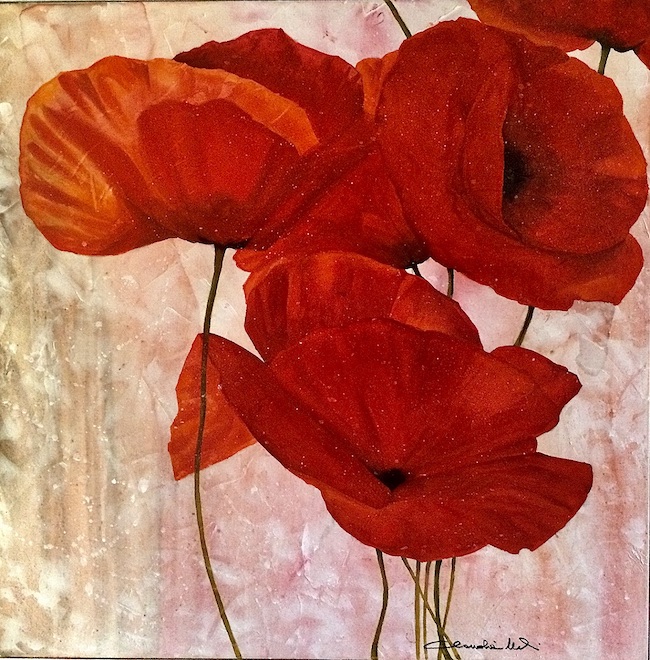
Alla serie di nudi l’artista affianca anche delle opere floreali che hanno però un’accezione Metafisica perché i fiori sono decontestualizzati e posti al centro della tela assumendo un’aura misteriosa, semplice ma tuttavia densa di lirica poetica, quasi mistica nella loro bellezza accompagnata costantemente dalla velatura dello sfondo che non fa che esaltare la preponderante presenza.
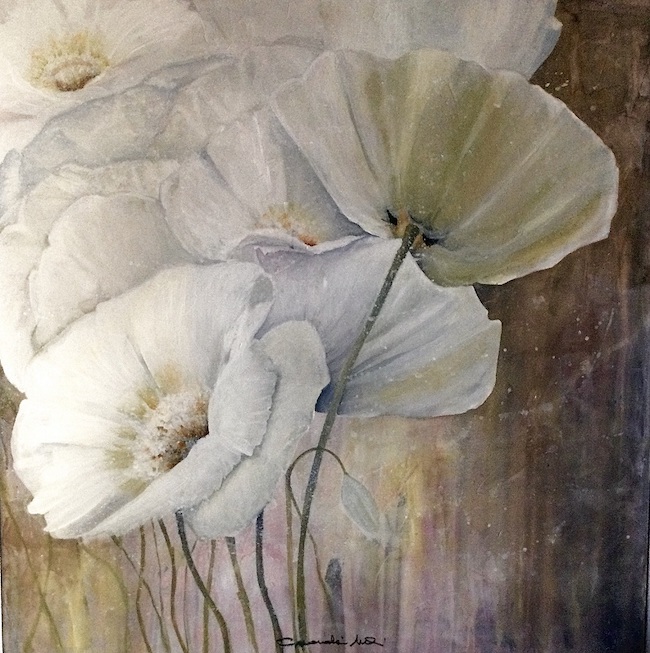
Claudia Nardi è artista e restauratrice, ha all’attivo diverse mostre personali e collettive in Italia e all’estero; le sue opere fanno parte di collezioni private di tutto il mondo e sono inserite nei principali annuari e cataloghi di arte moderna e contemporanea. Suoi restauri su tela e su tavola sono presenti nel museo di Santa Maria Maggiore e all’Istituto del Preziosissimo Sangue a San Giovanni in Laterano, entrambi a Roma, ed è socia ordinaria dell’Associazione Cento Pittori di via Margutta.
CLAUDIA NARDI-CONTATTI
Email: puntoimmagine@tiscali.it
Sito web: https://www.centopittoriviamargutta.it/claudia-nardi/
Claudia Nardi’s veiled bodies suspended between introspection and the need to discover oneself
The focus on inner impulses that characterises contemporary art, that whirlwind of emotions, insecurities and destabilisations that cannot be separated from today’s frenetic rhythms and the loneliness of the individual deluded by the illusion of being in the midst of a multitude thanks to technology, sometimes tends to distance artists from that balance with a more aesthetic, more figurative approach, even if oriented to explore, precisely through the exterior, those intimate and inner sensations that are hidden in everyday life. Today’s protagonist gives life to artworks in which the female body is transformed into a means of deepening, of self-knowledge, of manifestation of a meditative need aimed at revealing all those thoughts, those reflections through which it is possible to take note of events, circumstances and consequences.
The fascination of the body in its nudity constituted an important fixed point for all classical art, as regards both painting and sculpture, because the perfection of form and attention to aesthetics were indispensable guidelines for depicting athletes, dancers and warriors, emphasising their physical perfection, strength and vigour, but also for inducing the public to consider nudity as something natural; slowly over the centuries, historical, allegorical and sacred painting also chose the nude to narrate events. Then, after the long pause of the dark years of the Middle Ages, painting also began to discover the female body in its pure and at the same time sensual, innocent but also provocative beauty, in which attention to aesthetics always prevailed over inner feeling. Francisco Goya with his Maya Desnuda, which scandalised the cultural world of the time for the fact that the artist had portrayed an ordinary woman, therefore no longer a mythological figure, within a modern context and without bothering to hide anything of her nudity, was the founder of a genre that has crossed all painting styles and that has made women the protagonists of the admiring and bewitched gaze of the greatest masters of all time.
Gustave Courbet depicted the female body in an explicit, almost pornographic manner in his Sleep and in the controversial Origine du monde, while Edouard Manet’s Olympia caused just as much scandal because of the profane appearance of the woman, who could be likened to a prostitute, and with which the artist perhaps wanted to highlight the habits of the male world of the time; and again in the Viennese Secessionism Gustav Klimt returned to the provocative yet elegant and refined essence of women in the paintings Nuda Veritas and Danae in which physical imperfection begins to take over but in no way compromises the sensuality and beauty of the female figures portrayed. Klimt’s path was extended by the Expressionist Egon Schiele, in whom the nude represented his personal way of expressing the sense of disorientation and desperation of an era between the First and Second World Wars, when all certainties had collapsed and the fear of losing one’s life led one to cling to it even through physical encounters. In him, attention to aesthetics took second place to feeling, to the relevance of the inner world that had to prevail, just as Lucian Freud, a member of the London School, stressed a few years later, in which the corpulence of the characters narrated expressed a psychological and inner unease, reflecting their inability to find meaning in life. Roman artist Claudia Nardi returns to the aesthetic perfection of the female body, displaying an almost Photorealist style in the attention to detail, in the description of the perfect form, which, however, veils, almost hiding, and envelops her protagonists in a silence necessary for them to deepen their dialogue with themselves, which can only come to life when they are willing to lay bare and observe their own interiority. Here, then, external nudity becomes a metaphor that the artist uses to suggest a path necessary to achieve self-awareness, that which is normally hidden between contingency and the need to appear at the best, forgetting to be.
The technique of blurring and veiling the main image serves to highlight Nardi’s discretion and reserve with regard to her characters, as if she were observing them but then leaving them to their own introspection, in the same way as a guide who knows how to step aside to allow awareness to grow and mature within each one. Not giving a specific identity by leaving out the faces becomes essential in order to instil in the observer greater participation, identifying with the feeling, approaching it through the emotional impulse, finding himself in a path of awareness that he has completed or knows he must complete; the choice of the female body is probably due to the awareness that very often the path of emotional liberation, of freeing oneself from an interiority caged by conventions and one’s own insecurities, is more incisive, starting almost from the woman and then spreading to the individuals around her, to the rest of society. The poses of the bodies are classical yet contemporary because it is through a single gesture, a particular still image that Claudia Nardi manages to express the sensation that her protagonists face, from time to time, in that moment of introspection which will be followed by an intense awareness, from which an evolution, a modification can start precisely because understanding, questioning and accepting the course of events is necessary in order to hold back what is necessary teaching and let go of what cannot be modified and therefore taken as the cause that has originated determining effects. The artist is incisive in recounting the emotions only through a glimpse, a fragment of the existence of those women who represent the delicacy, fragility but also the inner strength that enables them to make a journey of knowledge, to deepen their understanding of events but also to overcome their outcomes. Yet in order to make that journey it is also fundamental to envelop oneself in an evocative and essential silence, which Nardi expresses through the veils that seem almost to want to hide what in reality cannot help but emerge, appearing as suffused atmospheres indispensable for encouraging inner listening, as if only after being in the fog is it possible to find the light. In some cases the women are portrayed with their backs to the observer, almost as if they wanted to maintain a necessary detachment from the outside world, almost as if they decided to refuse to expose themselves because doing so would make them feel more fragile, in danger and unprotected; in other canvases, they seem to withdraw into themselves, hugging their legs to curl up and find that contact between inside and outside in virtue of which they can meditate, reflecting on everything that has been up to that moment and glimpsing what can be from then on, despite the uncertainties, in defiance of the falls which, if it is true that they have compromised stability and security, on the other hand have led to discover her own strength, her determination to get back up. Other canvases, on the other hand, show a marked self-awareness, the certainty of knowing what to want and which direction to take to achieve it, and so the juncture immortalised by Nardi simply becomes a moment of pause, of gathering ideas and planning the next objective, a calm before the next storm which is not frightening because it represents the fulcrum of existence. In addition to the series of nudes, the artist also creates floral paintings that have a Metaphysical meaning because the flowers are decontextualised and placed at the centre of the canvas, assuming a mysterious aura, simple but nevertheless full of poetic lyricism, almost mystical in their beauty, constantly accompanied by the veiling of the background that only enhances their preponderant presence. Claudia Nardi is artist and restorer, she has had several solo and group exhibitions in Italy and abroad; her artworks are part of private collections all over the world and are included in the main yearbooks and catalogues of modern and contemporary art. Her restorations on canvas and wood are in the museum of Santa Maria Maggiore and in the Institute of the Precious Blood in San Giovanni in Laterano, both in Rome, and she is an ordinary member of the Associazione Cento Pittori di via Margutta.


